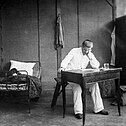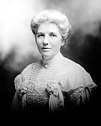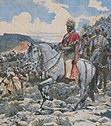| Millennium |
|---|
| 2nd millennium |
| Centuries |
| Decades |
| Years |
| Categories |
The 1890s (pronounced "eighteen-nineties") was a decade of the Gregorian calendar that began on January 1, 1890, and ended on December 31, 1899. In American popular culture, the decade would later be nostalgically referred to as the "Gay Nineties" (Gay as in 'carefree', 'cheerful', or 'bright and showy'). In the British Empire, the 1890s epitomised the late Victorian period.
As European powers continued their colonial expansion, the decade saw the defeat of Edi (1890), Siam (1893), Morocco (1894), Dahomey (1894), Arab-Swahili warlords (1894), Lombork (1894), Pahang (1895), Merina (1895), Zanzibar (1896), Khaua and Mbandjeru (1896), Ashanti (1896), Matabeleland (1897), Pedir (1898), Sudan (1899), and various north-west Indian tribes and states. Whereas most colonial campaigns were successful, Italy faced a significant defeat as it failed to conquer Ethiopia, being decisively defeated at Adwa (1896). Furthermore, the second half of the decade saw the final unravelling of Spanish America, which began with insurrections in Cuba (1895) and the Philippines (1896) and ended with the Spaniards' defeat at the hands of the United States in 1898. Following the sale of various Pacific islands to Germany in 1899, the Spanish colonial empire would be restricted to Africa. Further in the east, Japan sought to expand its own empire, waging wars against Donghak (1894–1895), Qing China (1894–1895) and the Republic of Formosa (1895). Other conflicts included the Garza War (1891–1893), the Greco-Turkish War (1897) and internal conflicts in Samoa (1886–1894, 1898–1899), Afghanistan (1888–1893), Argentina (1890), Chile (1891), the Ottoman Empire (1891, 1893, 1894, 1895–96, 1896–1897, 1896), Mexico (1891–1892), Brazil (1893–1894, 1893–1895, 1899–1903), Peru (1894–1895), the South African Republic (1894), northwest China (1895–1896), Bolivia (1898–1899) and Columbia (1899–1902).
The decade was characterized by an international economic recovery following the Long Depression (1873—1896) and by the beginning of strong economic growth during the Belle Époque (1871—1914), driven by the innovations of the Second Industrial Revolution (i.e. electricity, gasoline, automobiles, artificial textiles, organic chemistry). The decade also saw the apogee of the coal-powered steam engine, which would subsequently be dethroned by the reciprocating engine, powered by refined petroleum. The supremacy of this new source of energy was confirmed when the world's first fleet, the Royal Navy, decided in 1910 to supply all its vessels with fuel oil. In the United States, the decade was marked by a severe economic depression sparked by the Panic of 1893. This economic crisis would help bring about the end of the so-called "Gilded Age", and coincided with numerous strikes in the industrial workforce. The economic depression sparked a political struggle over free silver and the collapse of the Third Party System. Concurrently in Australia, a banking crisis occurred, caused by the collapse of a speculative boom in the Australian property market. First-wave feminism made a significant breakthrough as a successful petition in 1893 resulted in New Zealand becoming the first country to grant women the right to vote.
From 1889–1890, a worldwide respiratory viral pandemic took place, resulting in 300–900 million infections and 1 million deaths. The pandemic is presumed to have originated in the central Asian city of Bukhara. Furthermore, in this decade, an epizootic of the rinderpest virus struck Africa, considered to be "the most devastating epidemic to hit southern Africa in the late nineteenth century".[1] It killed more than 5.2 million cattle south of the Zambezi,[2] as well as domestic oxen, sheep, and goats, and wild populations of buffalo, giraffe, and wildebeest. This led to starvation resulting in the death of an estimated third of the human population of Ethiopia and two-thirds of the Maasai people of Tanzania.[3] In 1891−1892, poor weather alongside government mismanagement in Russia led to a famine, causing 375,000 to 400,000 deaths. British India suffered two famines this decade, first from 1896–1897 and then from 1899–1900, due to draught and British policies. Famines also took place in Cuba and China. Major earthquakes of this decade include the 1891 Mino–Owari earthquake (7,273 deaths), the 1893 Quchan earthquake (18,000 casualties), and the 1896 Sanriku earthquake (22,066 people dead or missing).
The first international Olympic Games in modern history were held in Athens in 1896, with 241 athletes from across 14 nations competing. In the United States, the best-selling books of this decade (by year) were Beside the Bonnie Brier Bush (a collection of short stories, best-seller in 1895), Tom Grogan (a drama novel, best-seller in 1896), Quo Vadis (a historical novel, best-seller in 1897), Caleb West (best-seller in 1898), and David Harum (best-seller in 1898). The film industry, still in its infancy, continued to produce short films such as Le Coucher de la Mariée and The Kiss. Songs of this decade include "America the Beautiful", "Daisy Bell" and "Hello! Ma Baby".
In this decade, the world population grew from 1.5 to 1.6 billion.[4] The last living person from this decade, Emma Morano, died on April 15, 2017. Last living man from this decade was Jiroemon Kimura, and he died on June 12, 2013.
- ^ Phoofolo, Pule (February 1993). "Epidemics and Revolutions: The Rinderpest Epidemic in Late Nineteenth-Century Southern Africa". Past & Present (138): 112–143. doi:10.1093/past/138.1.112.
- ^ Van den Bossche, Peter; de La Rocque, Stéphane; Hendrickx, Guy; Bouyer, Jérémy (May 2010). "A changing environment and the epidemiology of tsetse-transmitted livestock trypanosomiasis". Trends in Parasitology. 26 (5): 236–243. doi:10.1016/j.pt.2010.02.010. PMID 20304707.
- ^ Normile, Dennis (March 2008). "Driven to Extinction". Science. 319 (5870): 1606–9. doi:10.1126/science.319.5870.1606. PMID 18356500. S2CID 46157093.
- ^ "Population | Gapminder". Retrieved 2024-04-21.







